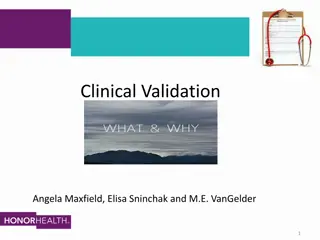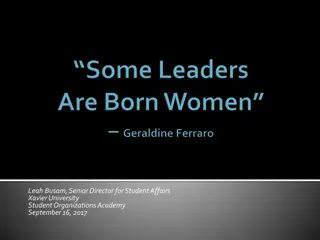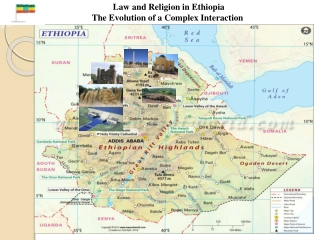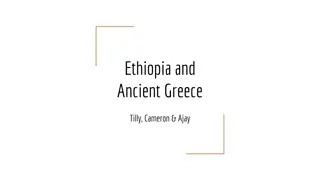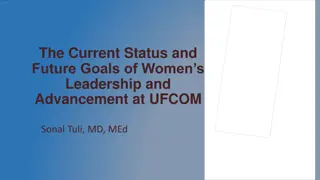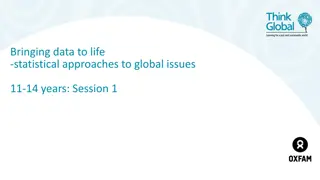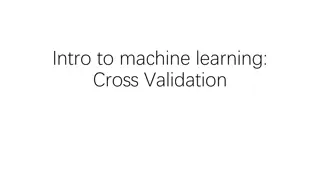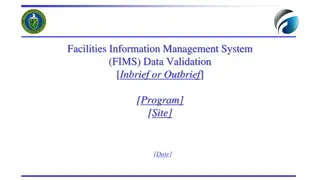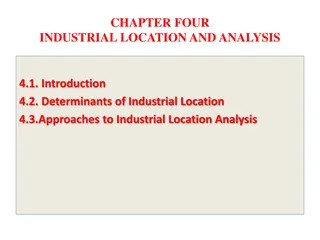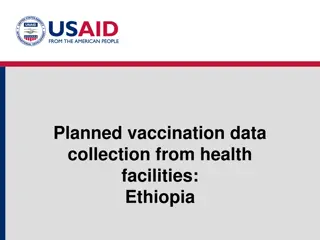Validation Workshop on the Status of Women in Leadership in Ethiopia
This validation workshop in Ethiopia assessed the status of women in leadership and decision-making positions in the legislative, judiciary, and executive branches of government. Despite their significant population representation, women are not equally represented in crucial roles. The study highlights progress made in increasing women's political engagement and provides recommendations to address barriers hindering their participation at all government levels.
Download Presentation

Please find below an Image/Link to download the presentation.
The content on the website is provided AS IS for your information and personal use only. It may not be sold, licensed, or shared on other websites without obtaining consent from the author. Download presentation by click this link. If you encounter any issues during the download, it is possible that the publisher has removed the file from their server.
E N D
Presentation Transcript
VALIDATION WORKSHOP on The Status of Women in Leadership and Decision- Making Positions in the Legislative, Judiciary and Executive Branches of the Government of Ethiopia Meseret Kassahun (Ph.D) and Befikadu Kidane (Ph.D) November 2020
BACKGROUND In Ethiopia, of the total 114, 964,000 population for the year 2020, 57,447,000 (i.e. 49.9%) are women. However, Ethiopian women are not represented in leadership and decision- making positions equally with men; The availability of legislative and policy provisions in the country, however, has helped to gain significant progress towards increasing women s active political engagement that includes voting, exercising public power by holding public office at different levels of administrations at local, regional, federal level representations as enshrined in the Constitution
BACKGROUND [CONT.] improvements were observed in the representation of women in regional councils from 5.4% representation in 1995 to an average of 40% in 2015. In the judiciary, the representation of women has reached 20% from 16.9% in 2009/10 the representation of women in the legislative branches at the Federal level has shown a significant improvement from 2% representation in the House of Peoples' Representatives in 1995 to 38.8% in 2015. the executive branch at Cabinet level has shown the biggest improvement in representation, going from 13% at Minister position occupied by women in 2005, to now constituting 50% at the federal level 1995 2009 2010 1995 Now
BACKGROUND This study, therefore, provides nationwide data on the number of women represented at all levels of the federal and regional governments and the existing cultural, structural as well as emerging barriers hindering women from equal participation and effective representation in these government positions. The study also provides contextually relevant recommendations and strategies to address the problems noted regarding women s participation in leadership and decision-making positions in the three branches of government at both federal and regional level.
OBJECTIVES of the STUDY The Purpose of the study is to assess the current status of women s representation in leadership and decision-making positions in Ethiopia. Specific objectives of the study include: Gaining a national sex disaggregated data on representation in leadership and decision- making positions in the legislative, judiciary and executive branches of the Ethiopian Government Identifying the measures undertaken by the federal and regional governments to narrow down gender inequality
OBJECTIVES [CONT.] Identifying the multifaceted challenges constraining women from being equally represented across the various levels of decision making and leadership positions. Recommend strategic and tailored measures which can be undertaken to increase women s national representation and participation in leadership and decision-making positions. While doing so identify international, regional and national best practices to achieve results in terms of increasing women s participation and representation.
CONCEPTUAL FRAMEWORKs Intersectionality: Intersectionality refers to the interconnected nature of social categorizations such as race, class, and gender as they apply to a given individual or group, regarded as creating overlapping and interdependent systems of discrimination or disadvantage. Gender and Leadership: leadership is a process whereby an individual influences a group of individuals to arrive at a common goal. Personal factors-personality characteristics, attitudes, and behavioral skills of women; Socio-cultural beliefs; socio-economic and Institutional/government-related factors in practice operating intersectoral
RESEARCH QUESTIONS 1. What is the current status/ proportion of women in leadership and decision-making positions in the legislative, judiciary and executive branches of the Ethiopian Government as compared to men? 2. What measures have been taken to narrow down gender inequality in leadership and decision making in the three branches of the government? 3.What factors encourage and/or constrain women from aspiring leadership and decision-making positions and meaningfully participate and/ or represent themselves in leadership positions in the legislative, executive and judiciary branch of the Ethiopian Government;
Operational Definition Senior leadership position Refers to prime minster, Deputy prime minister, Members of the Cabinet or minsters, state minster, Agency or Authorities, Executive directors, Commissioners of commissions at the federal level and presidents of the Regional State, Deputy Presidents, Members of the Regional Cabinet/ bureau head, vice bureau head, Chief Executive directors, and Commissioners of regional agencies/authorities/commissions and similar positions at zonal and woreda levels. Mid-level leadership position: Refers to merit-based professionals working at the various government organs who occupy - directors or processor owner positions from the federal to woreda levels. Junior level leadership position: Refers to team leaders working in different government organizations from the federal to woreda levels.
METHODOLOGY Research Design Concurrent mixed method cross-sectional research design Data sources Primary and Secondary Data collection methods Quantitative and Qualitative Data collection tools Quantitative: Survey and Administrative data Pilot testing Qualitative KII, and FGDs Literature/document review (Policies, legal documents, published and unpublished literature)
METHODOLOGY (CONT.) Qualitative : Purposive sampling (Representatives of women in senior, middle, and junior-level decision-making positions were included from government. A total of 165 KIIs and 101 FGDs were conducted Quantitative: Ministry of Public Service and Human Resource Development (2017) report, there are a total of 53,708 leadership positions in the three branches of the Ethiopian government (data for Somali regional state was not included) at a 95 % level of confidence for a population of around 50,000, researchers recommend a representative sample size of 593, and have increased the sample size to 733. to determine the number of sample respondents from the federal and each region, proportionate stratified random sampling was used. disproportionate stratified random sampling is used to increase the number of women respondents
METHODOLOGY (CONT.) Qualitative Data Analysis Narrative method is used (several steps: verbatim transcription of the interviews, followed by developing relevant themes as per the tentative outline of the report. Interpretation is the next step to integrate views of different groups on specific issues of discussion). Quantitative Data Analysis SPSS, Version 24 was used; Descriptive statistics, such as graphs, percentages, mean ratings, Standard Deviations (SD), and inferential statistics such as Chi-squares, an independent t-test, paired wise test and one-way ANOVA were used to analyze and interpret data for the study. Mixed-Data: separately analyzed administrative and quantitative data and the interpreted qualitative were integrated at the stage of analysis
STATUS of WOMEN in LEADERSHIP POSITIONS (Legislative, Executive, and Judiciary) WOREDA
STATUS of WOMEN[CONT.] ZONAL
STATUS of WOMEN[CONT.] Regional level analysis
STATUS of WOMEN[CONT.] FEDERAL : EXECUTIVE branches Women s representation in the senior,middle, and junior leadership of the executive branches of government are 19.4 %, 24.8 %, and 27.4 % respectively 1800 1688 1600 1349 1400 M F 1200 1000 %F 800 638 600 444 400 175 200 42 19 25 27 0 Seniors Middles Juniors
STATUS of WOMEN [CONT.] 115 120 100 89 Federal: Judiciary The percentage of female judges in the Federal Supreme, High, and first Instance Court is 27%, 18%, and 60% respectively. Women s representations in the supreme and higher courts are below 30%,while the number of women in the 1st instance courts exceeds 50% 76 80 60 60 35 40 27 20 18 13 20 0 Supreme Court High Court First Instance Court M F % of Female
STATUS of WOMEN [CONT.] 174 200 151 600 547 150 60 100 46.5 500 6 4 50 0 Male Female % of Female 400 Members of Standing Committee Chair persons of Standing Committee 300 212 FEDERAL: LEGISLATIVE Women s representation in the House of Federation and in the House of Peoples Representatives is 32% and 38.4% respectively. The representation of women in the House of People s Representatives Standing committee leadership constitutes 60% although men dominate the number of standing committees membership 200 104 100 49 32 38.7 0 Male Female Totla % of Women House of Peoples Representatives House of Federation
STATUS of WOMEN [CONT.] General level analysis The Regional average of women s representation is calculated to stand at 26.9%; the proportion of women being one in three in leadership and decision-making positions in the government branches. The federal average is 28.5%which is surprisingly lower. the average proportion progressively decreases as we move from Woreda (29.5%) to Zonal (22.8%), and to regional levels (21.9%).
STATUS of WOMEN [CONT.] Regional comparisons in Government Branches 50 Regional Zonal 45 45 42 41 40 Woreda 37 35 35 31 29 30 30 29 30 28 25 26 26 26 25 24 24 24 23 21 21 19 19 20 17 16 15 13 11 10 7 6 6 5 0 Tigray Benishangul Afar AA SNNPR Amhara Harari Gambella Somali Oromia Dire Dawa
STATUS of WOMEN [CONT.] Women s Representation in the Cabinet The total women s participation ( Federal and regional levels together) in the cabinet is 20 %, one out of five Women cabinet membership is better at the federal level with (50 %) followed by Tigray regional state (47 %), Benishangul- Gumuz ( 29 %), Diredawa ( 27 %) and Oromiya ( 21 %) all above the national average,, while the remaining regions are all below Women s participation in the cabinet at the federal and regional levels is very low.
STATUS of WOMEN [CONT.] Women s Representation in the Cabinet: Zonal level is 18 %for women with Tigray region with ( 48 %), and Addis Ababa with (22 %), and Oromiya (20 %)a little bit above the national average. Woreda cabinets-for women s participation is (17 %) while still the Tigray region with better (36 %), followed by Addis Ababa (28 %) and Oromia with (24 %), all above the national averages. women s participation in the cabinet is very low where the majority of the positions are occupied by men at all levels except at the federal cabinet position.
PARTICIPATION of WOMEN in Political Parties Women s Representation in Political Parties Data obtained from the National Election Board of Ethiopia (NEBE) shows a total of 105 political parties by the end of December 2019 Percentage of Women as Founding Members in the different Political parties A total of 72,493 founding members were registered where 14,254 are women. Women make up an average of 19.7% in the founding members 25000 22171 21776 20000 18078 15000 10000 8100 5034 (23%) 4495 (20%) 3316 (18%) 5000 2368 1222 (15%) 187 (8%) 0 1550 and less members 1551-2000 members 2001-2500 members 2501-3000 members 3000 and above members M + W % of W
POLITICAL PARTICIPATION [CONT.] Frequently mentioned Challenges: The hostile social and political environment Patriarchal political culture that encourage men to become politicians and pushes women to stay away from politics Political violence that scares women from engaging in civic and political life A woman key informant reported: Since our country s politics is incredibly complicated and often so many deaths caused by the political turmoil is involved, politics itself is perceived and understood as something scary. When I was young, I grew up hearing about the bloodshed and brutality during Mengistu s era. No parent wants his/her children to involve in politics as we have a very bad experience in recent stories.
MEASURES UNDERTAKEN to INCREASE WOMENs REPRESENTATION in LEADERSHIP POSITIONS Normative and Policy Measures Domestication of International and regional conventions have inspired the national legal and policy frameworks The inclusion of affirmative action provisions in the Constitution as well as in the Labor Proclamation No. 1156/2019, Federal Civil Servants Proclamation No. 515 of 2007, and the Higher Education Proclamation No. 351/2003 and related directives as important measures GTP I & II as well as the Ethiopian Women Development and Change Package emphasis on women s equal political participation
MEASURES [CONT.] Reinforcing legislative and policy provisions; Creating awareness on women s equal rights in decision and leadership positions as stipulated in existing legislation and policy provisions, Capacity building for women employees at all levels in the three branches using short term and long-term training strategies; Implementation of the affirmative action; Strengthening the institutional mechanisms for gender equality are the frequently mentioned practical measures.
MEASURES [CONT.] A male key informant from a federal ministry reported Women have equal rights with men in all economic, social and political activities. This is clearly stated in our Constitution and other policy documents. If we take the Women Policy and the Development Package, it is developed in line with the constitutional provisions of women s equal rights. However, the implementation is far from what is enshrined in the Constitution at all levels. This is mainly because of attitudinal challenge . I do not think it is a lack of knowledge on the legal and policy provisions by policy implementers at all level. Women A woman key informant among regional Supreme Court judges noted: Our country has adequate legal and policy provisions. The problem lies with the implementation of the laws and policies. This is also related to lack of positive attitude that accepts women s and make efforts to ensure their equal representation from our side [civil servants]. To this, we have been working to raise awareness that aimed at changing the attitude. equality change
MEASURES [CONT.] On Capacity Building Initiatives A key informant from SNNPR also reported: We know most women in junior positions have great potential. If they are supported, we know they would become great leaders. Through our ministry support at Federal level, we have been planning to offer scholarship opportunities and have been encouraging many women to apply for them and utilize them to the best they can. In collaboration with the Ethiopian Civil Service University, we are able to help many female employees who had only diploma to get Bachelor of Arts degrees. There are also women who have gone to do their MA after receiving the women scholarship. Similarly, a key informant from the ministry of Health noted: Our ministry has been working in capacitating the healthcare workforce, especially the women, in junior positions. Short term trainings on leadership skills have been provided. Very recently, we have initiated a mentorship program. In this mentorship exercise, we are expecting key leaders in the ministry to mentor women who are in junior positions through guiding them and enabling them to acquire relevant skills and knowledge, like an on-job training. We believe that they will learn and gain more skills from the experience of other leaders.
MEASURES [CONT.] Mentoring women in junior positions has been used as a strategy to enhance women s aspiration to become leaders and increase their capacity to lead. key informants unequivocally agree that the capacity building efforts towards increasing the leadership knowledge and skills need further strengthening and expansion to reach out all junior level women employees in all sectors at all level and branches of government to truly see a lasting impact and change.
AFFIRMATIVE ACTION A broad range of voluntary and mandated policies and procedures intended to provide equal access to educational and other opportunities for members of historically excluded groups such as women. Article 35 (3) of the Constitution states: The historical legacy of inequality and discrimination suffered by women in Ethiopia taken into account, women, in order to remedy this legacy, are entitled to affirmative measures. The purpose of such measures shall be to provide special attention to women so as to enable them to compete and participate on the basis of equality with men in political, social and economic life as well as in public and private institutions
AFFIRMATIVE ACTION [CONT.] Key informants, however, reported that the country neither has a stand-alone affirmative action law or policy or a clear interpretation of the constitutional interpretation. This study found that: Labor Proclamation No. 1156/2019 Federal Civil Servants Proclamation No. 515 of 2007 The Higher Education Proclamation No. 351/2003 were identified as proclamations with clear provisions on women s entitlement to affirmative measures
AFFIRMATIVE ACTION [CONT.] Implementation of affirmative measures, however, varies from region to region and sector to sectors Partly explained in terms of lack of proper interpretation of the affirmative measures as well as lack of relevant standardized implementation guideline on the measures for all sectors at all level A woman key informant reported: We do not have a policy on affirmative action. Only few sectors have specifically addressed affirmative measures through developing relevant directives and issues. Except the higher education proclamation that has clear provision for students coming from emerging regions and women s entitlement, the rest of the affirmative measure needs to have clear guideline. It would be also beneficial to develop a standalone affirmative action policy.
AFFIRMATIVE ACTION [CONT.] The country needs to use mandatory quota system in order to increase women s representation In explaining how voluntary quota could help achieve women s participation in the legislative branches of government, key informants mentioned the experience of Ethiopia s ruling party i.e. Ethiopian People Revolutionary Democratic Front (EPRDF). For instance, EPRDF s used voluntary quota system to demonstrate its commitment through nominating and deploying 40% of candidates during the 2015 national election. The current level of 38.8 % women member of parliaments, hence is the result of the self-imposed quota system. The free will of political parties to adopt quota system and the lack of a consistent mandatory quota system can lead to a regression in women s representation and eases the obligation of political parties to recruit women members
AFFIRMATIVE ACTION [CONT.] A woman legislative member in the federal parliament reported: One of the achievements of my party [EPRDF] is its internal commitment and principle towards increasing women s representation in the legislative branch. The 2015 election was an opportunity to prove our commitment towards gender equality. We [EPRDF] were able to deploy many candidates with a voluntarily commitment to achieve a minimum of 30% representation. It has worked. However, I am not sure if that can be sustained in the upcoming election. Because there is no mandatory requirement for political parties to increase women party members and candidates. Currently, Ethiopia has a revised Proclamation on electoral and pollical parties that replaced Proclamation No.573/2008. The revised Proclamation Electoral and Political Parties has more provisions that in addition to the requirement of female members of the party and the number of females in leadership positions. Accordingly, Article 74 (4) stated any political party when conducting election for leadership position shall ensure gender representation consideration. Compared to the previous proclamation has more gender focused provisions and its impact is yet to be seen.
ACHIEVEMTNS and GAPS in POLICY MEASURES Achievements Gaps Progress on women s representation in the leadership and decision making has been made. Existing policy and legislations that have created a public value in framing women s equality issues a public policy agenda. Institutionalization of gender machinery Increased girls and women s participation in education The timeliness of the National Women Policy, Poor awareness; Poor implementation; Lack of standardized indicators; Lack of monitoring and evaluation mechanisms; Poor financing mechanisms, and Lack of institutionalized intervention
ACHIEVEMTNS and GAPS[CONT.] A woman Key informant from Tigray). I have benefited from the affirmative action when I was selected to study my graduate degree. A woman Key informant from Oromia In our institution add five more points as a bonus when women apply for leadership positions once they have made it to the last phase and if they score equal with a man competitor . Our requirement for women applicant is a little lower than men applicants in terms of their GPA or years of experience that is required for the positions A woman Key informant from Tigray The affirmative actions taken so far has helped to narrow the huge gender gap between women and men in leadership positions and I believe if affirmative actions were not taken, I do not think we would have reach to the level we are
ACHIEVEMTNS and GAPS[CONT.] Increased the participation of women in the legislation branches of government A male key informant from the House of People s Representatives noted: Thequota system that EPRDF adopted to reserve at least 30% of seats in the regional councils and federal parliament in fact helped to have more women to get representation in the legislative branches of the government. In fact, this was also complemented by our party s commitment to genuinely increase women srepresentation . Another female key informant with a State Minister position also reported: I was first invited to run for regional council and key party leaders suggested that I should represent my region at Federal level. I am sure they included women because it was a requirement from our party [EPRDF] to ensure the party s commitment to apply at least the 30% quota for women. As a result, I became a member of the House of Peoples Representatives .
PATHWAYS to LEADERSHIP POSITIONS Membership and affiliation to the ruling party is the most frequently mentioned route for both men and women to ascend to leadership and decision-making positions within the state structures and government organs; Legislative: women to ascending to leadership position to the legislative branch of government, they need to be members of political parties; Executive and judiciary: One would assume that successful recruitment of both men and women to senior level positions would be based on merit. But, affiliation with the incumbent party, being a member of the dominant ethnic group of a specific region, education background, and self-confidence as major contributing routs to ascend to leadership positions. Post 2018 leadership assignment at Federal Level however shows that non-party affiliated individuals are obtaining leadership position .Has yet to trickle down
BARRIERs of WOMENs PARTICIPATION in LEADRSHIP and DECISION MAKING POSITIONS Positive ratings are higher (mean=3.6) than negative ratings (mean=2.3) suggesting that participants attitude is favorable there is a tendency to believe that women are capable of assuming leadership and decision-making positions. average ratings are lower than the rating value of agree to the qualities and capacities of women. Although the majority seemed to entertain positive views, a sizeable proportion (about 21%) of the participants entertained negative views about women s representation in leadership position and this is an amount that can t be undermined.
BARRIERS [CONT.] Indirect attitude measures also suggest that participants endorse measures that at the moment put women at a disadvantage. Education (70%) and experience (50%) are important factors for assigning women to a leadership position while only 28% regard the need to consider gender in the assignment process. This kind of attitude is likely to put women at a disadvantage in competing for leadership positions.
BARRIERS [CONT. To a slight extent (2) To a moderate extent (3) To a great extent (4) To a very great extent (5) Me an To almost no extent (1) Items to be rated Personal Barriers Most women avoid leadership responsibility due to their own low self -efficacy Lack of adequate support at family level keeps women away from the leadership position Women s lack of willingness deter them from aspiring leadership position Women are considered unfit for leadership due to their submissive nature Women are kept away from leadership position owing to their low emotional stability Women shy away from assuming leadership due to their low assertiveness Lack of adequate leadership knowledge prevents women not to assume the position Women are assumed naturally unfit for leadership Women are considered unfit for leadership due to a perceived lack of natural charisma Women avoid leadership role as they lack perseverance in tense situation Women avoid leadership responsibility as they are soft-hearted Women avoid leadership as it may distort their relationship with others Personal barriers total Personal 143 187 150 129 54 2.6 82 182 164 165 62 2.9 88 196 178 142 51 2.8 162 213 136 97 42 2.5 203 185 129 94 46 2.4 197 175 157 91 39 2.4 201 189 114 104 36 2.4 177 185 124 102 66 2.5 169 203 137 105 44 2.5 201 184 142 88 33 2.3 220 189 138 70 33 2.2 250 170 130 74 26 2.2 2.45
BARRIERS [CONT.] Family work balance Women are burdened with double responsibility in domestic as well as public affairs. they have also reported few cases where the children/family well-being is compromised as a result of women s decision to take up leadership role in their community A key informant from Oromia noted: I was selected as one of the most successful woman leader of the year in 2019 and I was given a leadership training opportunity to China because of my performance. This is a reward for me as a woman leader. However, my husband did not like my scholarship and refused me not to go- it was a leadership training, you see. After I came to my current position, I also got a training in India for ten days he [my husband] refused again, I don t have a capacity problem, but I have a family problem, many of my challenges are family related By the way, many women leaders are divorced for the same reasons or complaints, If you take my husband he is from another profession in my case it is not the public or other individuals it is from my own family .
BARRIERS [CONT.] Self-efficacy and confidence Women themselves do not believe on their own capacities to lead. A female key informant reported: We [women] are not nurtured to be assertive and confident in our knowledge and ability. Although we know, what should be done, if men are around us, we tend to let them talk and we sometimes also tell them what should be done, and they are very good in presenting those ideas. They are smart and are not shy to express their ideas although their ideas are irrelevant to the issue at hand. Lack on self-belief contributes to the state of poor self-confidence. Self-confidence is often about a mind set on one s own ability and skills. Another woman key informant reported: The master key to become a successful leader is to believe in oneself. This is a universal truth. I think maybe that is why most women are held back in a way, we don t believe in ourselves and therefore we don t have the self-confidence.
BARRIERS [CONT.] Readiness for an Academic Empowerment Lack of academic preparation as a major personal challenge for women s ascendance to leadership positions. Leadership requires a combination of knowledge, skill, attitude and self-confidence and strong self-efficacy A female FGD participant from Harar also noted: Taking leadership positions starts with women s own readiness about taking responsibilities at a higher level and lead people. Most women are not ready, personally or academically, to pursue towards leadership positions. That is our weakness. I do not know any women who wanted to face the challenge that a leadership positions might bring on her way. I know some women who have the capacity, but they do not dare to aspire to lead. Even in a general office meeting, I feel ashamed because they do not say a word about any discussion points. Quantitative data: Educational level makes a significant difference in all but the institutional barrier (F2, 567=2.483, P<.084) in the sense that as education increases, the perceived level of impact of socio-cultural barrier increases participants with better educational level perceive limiting women from participation
BARRIERS [CONT.] To a slight extent (2) To a moderate extent (3) To a very great extent (5) To almost no extent (1) To a great extent (4) Items to be rated Socio-cultural Barriers Mea n The masculine orientation of the society discourages women not to aspire leadership79 House chores responsibility prohibits women not to assume leadership Lack of role model negatively affect women not to aspire leadership position Some women avoid aspiring leadership as they are considered assistant to men Some women avoid leadership for fear of lack of social acceptance Child-rearing responsibility prohibits women not to assume leadership The patriarchal mindset of society pushes women from leadership Women avoid leadership position due to religious dogma Socio-cultural barriers total 161 133 Socio-cultural 182 104 3.1 166 134 104 166 91 3.0 190 154 150 115 52 2.6 198 158 133 115 56 2.6 188 158 132 131 49 2.7 177 146 99 140 104 3.0 181 149 78 161 86 3.0 150 102 171 78 45 2.4 2.8
BARRIERS [CONT.] The socio-cultural barriers (2.8) in which the following specific factors were found to be perceived as having moderate or more impacts: The masculine orientation of the society discouraging women not to aspire leadership House chore responsibilities prohibiting women not to assume leadership Child-rearing responsibilities prohibiting women not to assume leadership Patriarchal mindset of the society pushing women from leadership
BARRIERS [CONT.] To a slight extent (2) To a moderate extent (3) To a great extent (4) To a very great extent (5) Items to be rated Economic Factors To almost no extent (1) Mean Women do not think about assuming leadership as they do not have economic freedom 193 141 91 43 180 2.4 Women do not have the opportunity to aspire leadership as they have to win their daily bread 195 141 122 63 131 2.7 Women develop inferiority feelings due to economic dependence. 198 117 129 69 131 2.7 Women want to maintain their assistant position not to lose the financial gain 174 140 101 43 181 2.5 Leaders are assumed to be economically better-off, which most women do not have. 156 149 129 80 Economic 131 2.8 Economic barriers total 2.62 Barriers overall total 2.67
BARRIERS [CONT.] Improvements in the attitudes of participants towards women s representation in leadership positions compared to the expected traditional negative views Different efforts: the current reforms by the government, gender-based intervention activities undertaken by government and non-government actors, the educative role of the media, better educational opportunities availed in more recent years and others. The capacity building training and male political leaders engagement activities undertaken by UN Women Ethiopia and its implementing partners could be considered as an example in this regard. UN Women Ethiopia in collaboration with MoWCY, Amhara and Oromia BoWCY, National Election Board and Ethiopian Broadcast Authority have provided different capacity building trainings to women leaders and aspirants on transformative leadership and gender equality, mentoring programs that can positively impact women s leadership roles and attitudes .
BARRIERS [CONT.] Organizational Barriers Patriarchal institutional structure: men s workplace dominance Less professional respect from colleagues Confusion between toughness vs compassion Informal organizational culture Lack of support Ethnicity and the politicization of ethnic identity in leadership
CONCLUSION Women s representation at the federal executive branches of the government and top ministerial position is improving due to the strong commitment of the current government to ensure gender equity in leadership. Although there is still a long way to go in terms of women s representation in leadership, particularly at the legislative and executive branches, has shown promising progress while their representation at the judiciary branch is still lagging. Despite the improved representation at the federal levels, significant disparities have been observed in women s representation at the regional level across the three-state structures.



